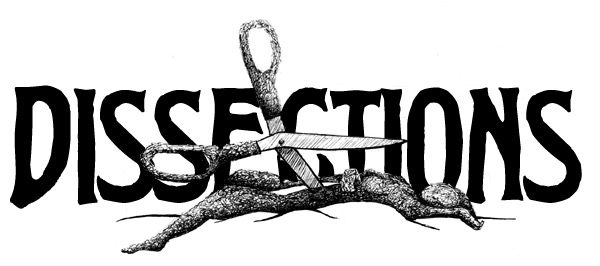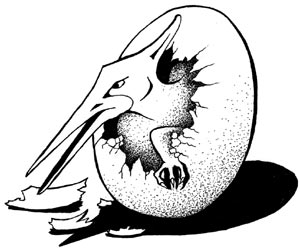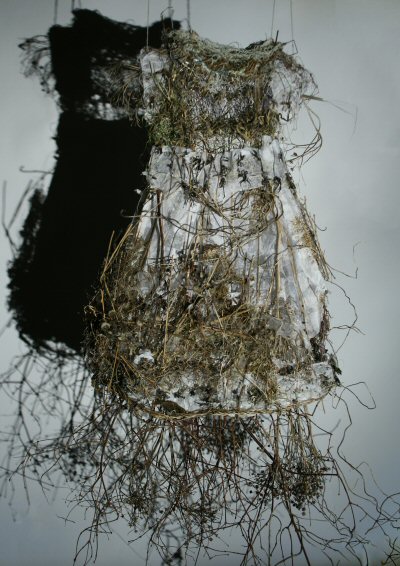[an error occurred while processing this directive]



Artwork: Dress by Dagmara Rudkin
Neptunes 2
Gina Wisker
There’s a rush of noise as the door opens to
hot, loud music.
Fishermen’s songs from the wildness of a sea
believed tamed in our century
kept at bay beyond the railings
jutted into by the pier.
A haven, the snug , overheated, noisy pub.
Sometimes raucous, it’s joining you in, shutting out
the cold night sky,
the dark clouds and the rain and your loss.
She’s there again, at the far table
in the 17th century, fisherman’s pub on the
quaint ancient row of cottages.
Electric lanterns, cobbled walks. She’s
calling you to sit with her.
Like those other evenings.
But tonight
your heart hurt, your memories jagged.
Your icy loneliness. It’s a lifesaver.
Palpable, the warmth of the welcome
solves it all and gradually relaxing as
the pints of thick dark beer give way to rum.
The outpourings met with consolations
with increasing understanding
with a turning and a physical touch
long lost, long ago and longed for.
She’s a
sea urchin wild, welcoming, laughing, consoling.
And she tells you little, while you pour your heart out
warming to her with her green eyes and her hair
shifting, waving.
Her keen attention like a warming potion
drawing you in.
And all too soon ‘It’s time’ they call, ‘it’s
time now
ladies and gentleman.’
And stumbling out in the cold and dark, you’re all together laughing,
her arms round you, she’s propping you up
and guiding you down
the ancient cobbled streets.
More narrowing rows than you remember.
And the sea calls and lashes at the edge of the strand
as together you brave the elements, warmed still
from the rum and the heat and the love and the hope
the beginning and the new lease of life,
her caresses and her arms around you.
’Til at the water’s edge with her hair in your mouth
and her arms wound round you
and the salt of the sea in her taste and the
water so near she’s
rolling you over and over and
under and down.
Lost soul.
She’s taking you home now.
Where many have found their new futures.
And the sounds of men and the snug of the pub and the
daylight all lost
with only the waves and the closing of water and
her hair and her scales and her teeth and
the cold cold sea.
The embrace of the cold cold sea.
**************************************************************************
University Library
Gina Wisker
Blood drops on the page.
Liquid traces in the
secret sanctum of the grand library.
Occupational hazards of
excessive study,
of the long dark nights poring
over medieval or more recent, obscured texts.
An unwelcome discovery of some archived secret
the power revealed by accident to a lone, obsessional, researcher
in the secluded library carrel.
In the dim green light they’re
oblivious to the footfalls in the hushed chamber
the swiftly delivered piercing and the cries
Silenced.
In the place of timeless secrecy.
The meanings hidden. The words unread.
Closing down the scholarly.
Inquisitive
uninvited
unwanted.
Knowledge, power, secrecy essential to its ancient owners
kept silent down the centuries.
Again safe, still, sequestered, shut.
**************************************************************************
Review
Dangerous Bodies: Historicising
the Gothic Corporeal by Marie Mulvey Roberts
(Manchester University Press 2016. pp 258 +xiii)
Review by Gina Wisker
Marie Mulvey Roberts’ Dangerous Bodies is that rare, fine, rich mix of the scholarly and the visceral, perfectly suited to its topic of the Gothic corpus and corporeality, the text, context and the (usually bleeding) body. Dangerous Bodies dissects the literary corpus of the Gothic in its cultural and historical context, starting with the early literary days of tales of dangers, dank corridors, and bleeding nuns. Its intent is ‘to expose real-life horrors lying beneath the fictional terror and horror of gothic literature and film’ (p. 1), concentrating on the persecutors and persecuted, the gruesome and the occasionally disgusting (where the disgust of some vile oppressor concerning women’s bodies, blood, the Other is usually the problem). One of its unique contributions is to unflinchingly deal with abject bodies, fluids and behaviours, exposing as themselves the demons, those who perpetrate the abjection and the terrible invasive controlling violence which results from this abjection. The both brutal and intellectually informed power operated by the church, the law, medical science and the state is seen to cause political and personal, bodily invasion, mistreatment, a violent injustice born of fanaticism. Such physically brutal, bloody violence springs at varied times from the excesses of Catholicism, slavery, mutilation of women’s bodies, to the horrors of several wars, particularly the First World War and the Vietnam War. All of this sounds really quite excessive, and it is, richly excessive, but never the excess of pantomime, of the seeking after the showy, of mere shock and gore.
Each torment and bodily abjection, bodily invasion, each chapter of blood and Gothic horror is deeply steeped in the meticulous detail of very fine scholarship. This includes some extraordinary horrible propaganda images, especially in both ‘Nazis, Jews and Nosferatu’ (ch. 4) and ‘The vampire of war’ (ch. 5). The relentless tracking down of Gothic turns in historical moments presents an unarguable case concerning the dangers in which physical bodies (and minds) are placed under the distortions of grand controlling ideas about the regulation of the physical, particularly the sexual, female sexuality, the individual, and of inferiority regarding race and gender. The book is concerned about the laws and the medical, political and religious arguments concerning ownership of bodies and property, which lead to and licence degradation, castration, enslavement, brutalisation of bodies and of the lifeblood of the people whose bodies are under exploitation – by the organs of political, psychological and bodily control, whether the Catholic church (ch. 1), imperialism (ch. 2), medicine and the law (ch. 3), racism (ch. 4), or the tyrants and mind controllers who perpetrate war (chs. 4 and 5). Blood is definitely the life in this text, and its legal, psychological, physical, personal and political abjection and control is the work of institutions and those who buy into their versions of reality, and enforce others to follow, victim or victimiser. The historical, legal and medical detail is pursued, hunted down, exposed as informing the historical moments of control of dangerous bodies, considered dangerous because they offer a solid, corporeal contradiction to religious and political controls, and versions of what should be controlled. They offer the potential for refusal, questioning and revolt. So this is a book which bases radical questions of the imposition of the straitjackets of control of bodies, which human beings impose on each other, debasing enslaving and torturing with actions based in religious, racist, sexist constructs. With a surgical skill, Marie Mulvey Roberts has plunged her researcher’s questioning and refusal to accept lies and absences into the texts and the contexts from which they spring, and in which they are read.
The first chapter, ‘Catholicism, the Gothic and the bleeding body’ traces the Catholic legacy in the Gothic with parallels between Henry VIII and Manfred in The Castle of Otranto, usurers, legitimacy or illegitimacy. Parallels between the first Gothic novels and Catholicism or anti Catholicism are carefully traced, while the Bleeding Nun is seen in the light of the Terror of the French Revolution.
The exposure of the brutalising of the body under slavery is explored brilliantly through discussing Frankenstein (1818), and the body of the monster. It starts by situating slavery as a civil death, uses Alan Lloyd Smith’s identification of the slave narrative with the novel’s many modes of writing, stitched together like the monster, and links Shelley’s own history and that of her times and its concern with slavery. It considers Shelley’s alignment with the ameliorist tendencies of Canning, so the novel is perhaps both an indictment against dehumanisation and a warning against early, unmanaged release of slaves.
The chapter (ch. 3) on Dracula (1897) is equally highly original. It builds on the critical views of women’s bodies as sites of dangerous desires, and abjection. Blood is of course at the heart of this chapter and Marie Mulvey Roberts does not stop with fangs, demonised vampire women and Lucy being staked by her fiances and the forces of patriarchy led by Professor Van Helsing. Dracula is seen as a medical novel, and of its time. It exposes the legislating against female orgasm through vilifying masturbation and active female sexuality as a dangerous threat to patriarchal order, and so seen or presented here as both demonic and disgustingly gory, ‘the slaying of Lucy by Van Helsing and his team can be seen as a sublimation of the castrating surgeon and his assistants operating on hysterical female patients’ (p. 44). The texts relates to the ‘Victorian pathologising of feminist and Freudian hystericisation of women’s bodies’ (p. 94).
But she goes further, linking sexual surgery to a correction of women seen as immoral, physical, sexual behaviour which leads to hideous gynaecological operations.
Chapters 4 and 5 each deal in many ways with war. Chapter 4 explores the conflation of the Jew, especially the Wandering Jew figure, and the vampire. Dracula’s own arrival by ship, bringing plague and vampirism, is compared to the rats travelling on ships bringing pestilence and plague when they invade, spreading the Black Death across Europe. There are some extraordinary propagandist cartoon images of Jews as vampires, which are matched by those of Nazis as vampires in this and the next chapter, signalling vampirism as a metaphor for war and invasion. We are informed that Stoker’s own father-in-law retold gruesome and terrible tales of the Crimean war, while Dracula’s step by step invasion, and the counter invasion of Mona and some of the Crew of Light pursuing him to his Transylvanian lair resemble war tales of moves and counter moves. As Marie Mulvey Roberts notes, ‘war is the ultimate horror and supreme blood-sucker’ (p. 179) and chapters 4 and 5 break new ground in meticulously tracking this relationship through event, tract, image, text and fictional texts.
I really love this book. It does a particularly fantastic job linking excellent, sound scholarship in terms of history, popular beliefs, and the way in which these are developed in the Gothic texts of different times and places. It is immensely scholarly and pursues its argument with dedication, tracking through history, the texts chosen and all those other texts which link with the argument, in appropriate detail. It also has an abundance of genuinely new and very significant things to say: about Catholicism and a terrified, pathological male response to women, Gothic and slavery, Gothic interest in blood, surgery, in control of women’s sexuality and women’s bodies, terrors of Otherness and miscegenation, anti Semitism, and the horrors of war.
This book will change the way readers and scholars look at and interpret some new and those established, ostensibly familiar Gothic texts, including Dracula and Frankenstein. More broadly, it exposes the way the Gothic channels more overt and more covert disease/unease/terrors of its time (and of the times which replay the key texts), while sometimes it is critiquing them and more often, perhaps, it is reinforcing them.
References
Shelley, M. (1818) Frankenstein (London: Lackington, Hughes,
Harding, Mavor & Jones).
Stoker, B. [1897] (1979) Dracula (London: Penguin
Books).
**************************************************************************
